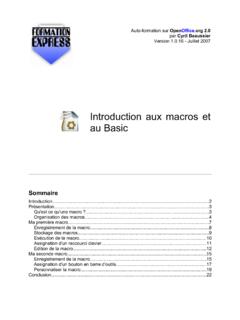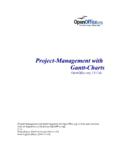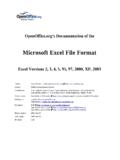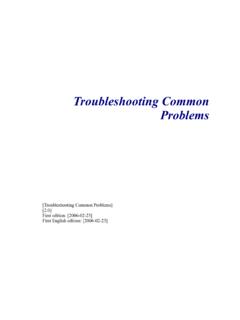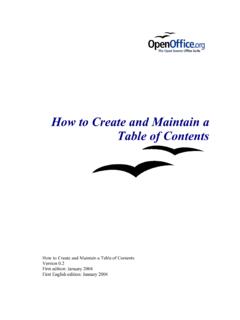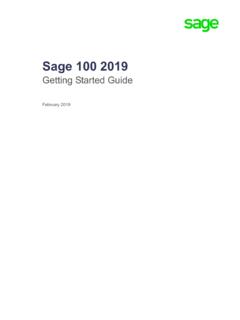Transcription of OpenOffice.org 3 Writer Guide
1 3. Writer Guide This PDF is designed to be read onscreen, two pages at a time. If you want to print a copy, your PDF viewer should have an option for printing two pages on one sheet of paper, but you may need to start with page 2 to get it to print facing pages correctly. (Print this cover page separately.). Alternatively, you can download a free PDF of the printed edition or buy a low-cost printed copy from You can also download an editable (.odt) version of this book from Copyright This document is Copyright 2005 2008 by its contributors as listed in the section titled Authors. You may distribute it and/or modify it under the terms of either the GNU General Public License, version 3 or later, or the Creative Commons Attribution License, version or later. All trademarks within this Guide belong to their legitimate owners. Authors Magnus Adielsson Agnes Belzunce Bruce Byfield Daniel Carrera Dick Detwiler Laurent Duperval Martin Fox Katharina Greif Tara Hess Peter Hillier-Brook Lou Iorio John Kane Stefan A.
2 Keel Michael Kotsarinis Sigrid Kronenberger Peter Kupfer Ian Laurenson Alan Madden Paul Miller Vincenzo Ponzi Scott Rhoades Carol Roberts Iain Roberts Gary Schnabl Robert Scott Janet M. Swisher Barbara M. Tobias Jean Hollis Weber Catherine Waterman Bob Wickham Linda Worthington Michele Zarri Feedback Please direct any comments or suggestions about this document to: Publication date and software version Published 27 December 2008. Based on You can download an editable version of this document from Contents Chapter 1. Introducing What is Writer ?..10. Starting The Writer Changing document Using the Starting a new Opening an existing Saving a Getting Closing a Closing Chapter 2. Setting up Choosing options that affect all of Choosing options for loading and saving Choosing options for Choosing options for HTML Choosing language Controlling Writer 's AutoCorrect Chapter 3. Working with Selecting Cutting, copying, and pasting Moving paragraphs Finding and replacing Inserting special Formatting Formatting Creating numbered or bulleted Using footnotes and 3 Writer Guide 3.
3 Checking Using language Using the Hyphenating Using Using word Using Line Undoing and redoing Tracking changes to a Inserting Linking to another part of a Working with Switching between insert and overwrite Counting the words in a Chapter 4. Formatting Choosing a layout Setting up basic page layout using Changing page Using columns to define the page Using frames for page Using tables for page Using sections for page Creating headers and Numbering Chapter 5. Printing, Exporting, Faxing, and Quick Controlling Printing a Printing Printing Sending a 4 3 Writer Guide Exporting to Exporting to other E-mailing Writer Digital signing of Chapter 6. Introduction to What are styles?..185. The Styles and Formatting Applying Modifying Creating custom paragraph styles: Copying and moving Deleting Assigning styles to shortcut Defining a hierarchy of Chapter 7. Working with Creating custom (new) Working with paragraph Working with conditional paragraph Working with character Working with frame Working with page Working with list Chapter 8.
4 Working with Graphics in Adding images to a Modifying an Using Writer 's drawing Positioning graphics within the Adding captions to Adding an image to the Graphic file types 3 Writer Guide 5. Chapter 9. Working with Creating a Formatting the table Formatting the table Data entry and manipulation in Additional table The Table menu and Chapter 10. Working with Using a template to create a Creating a Editing a Adding templates with Extension Setting a default Associating a document with a different Organizing Chapter 11. Using Mail What is mail merge?..341. Creating the data Registering a data Creating a form Printing mailing Printing Using the Mail Merge Wizard to create a form Chapter 12. Tables of Contents, Indexes, and Tables of Alphabetic Other types of Tools for working with 6 3 Writer Guide Chapter 13. Working with Master Why use a master document?..413. Styles and master Using the Creating a master Recommended method for creating master Editing a master Cross-referencing between Creating one file from a master document and its subdocuments.
5 431. Problem Chapter 14. Working with Introduction to Quick and easy field Using document properties to hold information that Using other fields to hold information that Using AutoText to insert often-used Defining your own numbering Using automatic Using fields in headers and Using fields instead of outline numbering for appendix numbering ..451. Tricks for working with Developing conditional Using placeholder Using input fields and input Chapter 15. Using Forms in When to use Creating a simple Example: a simple Accessing data Advanced form 3 Writer Guide 7. Chapter 16. Math What is Math?..491. Entering a Formula Common problem Math commands - Chapter 17. Customizing Customizing menu Customizing Assigning shortcut Assigning macros to Adding functionality with Appendix A. Keyboard Function keys for Shortcut keys for Shortcut keys for tables in Shortcut keys for paragraphs and heading Shortcut keys for moving and resizing frames, graphics and objects.
6 540. 8 3 Writer Guide Chapter 1. Introducing Writer What is Writer ? Writer is the word processor component of (OOo). In addition to the usual features of a word processor (spelling check, thesaurus, hyphenation, autocorrect, find and replace, automatic generation of tables of contents and indexes, mail merge, and others), Writer provides these important features: Templates and styles Page-layout methods, including frames, columns, and tables Embedding or linking of graphics, spreadsheets, and other objects Built-in drawing tools Master documents to group a collection of documents into a single document Change tracking during revisions Database integration, including a bibliography database Export to PDF, including bookmarks And many more Styles are central to using Writer . Using styles, you can easily format your document consistently and change the format with minimal effort. A style is a named set of formatting options.
7 Writer defines several types of styles, for different types of elements: characters, paragraphs, pages, frames, and lists. Often, you are using styles whether you realize it or not. The use of styles is described in more detail in Chapter 6 (Introduction to Styles) and Chapter 7 (Working with Styles). The other features of Writer listed above are also covered in detail in other chapters of this Guide . Starting Writer If you are reading this document in , you already know how to start Writer . However, if this is a printed version or a PDF. version, you may not know how to start Writer . So let's look at three ways to do that: From the system menu From an existing document From the command line 10 3 Writer Guide Starting from the system menu The most common way to start Writer is by using the system menu, the standard menu from which most applications are started. On Windows, it is called the Start menu. On GNOME, it is called the Applications menu.
8 On KDE, it is identified by the KDE logo. On Mac OS X, it is the Applications menu. When was installed on your computer, in most cases a menu entry for each component was added to your system menu. (If you are using a Mac, see note below.) The exact name and location of these menu entries depends on the operating system and graphical environment. Note for Mac users You should see the icon in the Applications folder. When you double-click this icon, a text document opens in Writer . To open the other components (Draw, Calc, Impress, Base), go to the File menu of the Writer window and select the component you want. OOo does not automatically put a shortcut icon on the desktop, but you can add one if you wish. If you don't know how to add shortcut icons for launching programs, please consult the help for your operating system . Starting from an existing document All Writer documents are associated with the Writer application.
9 This means that you can start automatically, simply by double-clicking a Writer document in a file manager such as Windows Explorer. You can spot an Writer document by its icon: . Note for Windows users If you have associated Microsoft Office file types with OOo, then when you double-click on a *.doc (Word) file, it opens in OOo Writer . If you did not associate the file types, then when you double-click on a Microsoft Word document, it opens in Microsoft Word (if Word is installed on your computer). You can use another method to open *.doc files in OOo and save in the *.doc format from OOo. See Opening an existing document on page 28 for more information. Chapter 1 Introducing Writer 11. Using the Quickstarter under Windows The Quickstarter is an icon that is placed in the Windows system tray during system startup . It indicates that has been loaded and is ready to use. (The Quickstarter loads library *.DLL files required by OOo, thus shortening the startup time for OOo components by about half.)
10 If the Quickstarter is disabled, see Reactivating the Quickstarter on page 13 if you want to enable it. Using the Quickstarter icon Right-click the Quickstarter icon in the system tray to open a pop-up menu from which you can open a new document, open the Templates and Documents dialog box, or choose an existing document to open. You can also double-click the Quickstarter icon to display the Templates and Documents dialog box. Figure 1: Quickstarter pop-up menu Disabling the Quickstarter To close the Quickstarter, right-click on the icon in the system tray and then click Exit Quickstarter on the pop-up menu. The next time the computer is restarted, the Quickstarter will be loaded again. To prevent from loading during system startup , deselect the Load During system Start-Up item on the pop-up menu. You might want to do this if your computer has insufficient memory, for example. 12 3 Writer Guide Reactivating the Quickstarter If the Quickstarter has been disabled, you can reactivate it by selecting the Load during system start-up option in Tools >.
